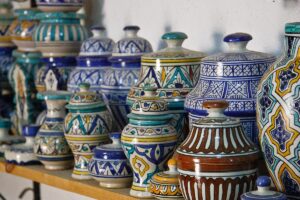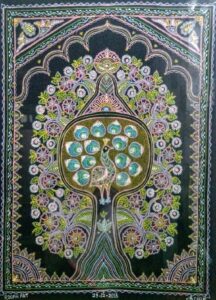Everything you need to know about
Black Pottery.
What is pottery?
Pottery refers to the process of making containers with clay.
In industrialization, modern pottery has two methods:
Commercial pottery
Commercial pottery deals with the ceramics manufactured in the factories.
These ceramics are solid, fragile and resistant to heat and corrosion.
These are manufactured by forming and afterwards a nonmetallic mineral, for example, clay, is fired at a high temperature.
Other examples can be earthenware and brick. Products manufactured by commercial pottery include:
- Flatware
- Bowls
- Mugs
- Cups
Studio pottery
Studio pottery is pottery made by artists and beginners or craftsmans artists working alone or in small groups, producing unique products.
Ordinarily, all phases of production are completed by the craftsmen themselves. Studio ceramics include products that can be used in daily life , for example, cookware, and products that cannot be used in daily life, for example, sculpture.
Studio potters also known as ceramists or as an artist who use dirt clay as a raw material.
Much studio pottery is either tableware or cookware, yet an expanding number of studio potters produce products that cannot be used in daily life.
Some studio potters prefer to be called ceramic artists or artists.
Studio pottery is practiced by potters across the globe.
What is Black pottery?
Black pottery, also known as black clay pottery, is a type of clay pottery known for its lush black body and mesmerising silver designs.
It is practised in Nizamabad in Uttar Pradesh, India.
It was enlisted for the Geographical Indication tag in December 2015.
How did it begin?
The black clay pottery took birth in Kutch district of Gujarat, India.
A few potters belonging to Gujrat moved to Nizamabad during the Mughal rule of Aurangzeb.
The silver designs were a concept taken from the handicraft of Bidriware practiced mainly in Hyderabad.
The pots were decorated using silver wires.
Around 200 houses are associated with the art in Nizamabad, and mostly the work is sent to the other countries.
However, still, the condition of these potters has stayed on the lower end throughout the years.
The Process
Potters use finely finished clay, which is accessible nearby.
The clay form is changed into various shapes and is upheld in the kiln.
Then, these clay wares are cleaned with a powdered vegetable issue and scoured with mustard oil.
For an attractive look, they are enhanced with flower and geometrical designs by using sharp twigs and are kept inside rice husks in an encased kiln which provides a novel sparkling dark surface to it.
The process of oiling and backing is done for the second time.
The scratches on clay wares are then loaded up with a silver colour powder of zinc and mercury washed with water and smoothened.
Other than Zinc and mercury, lead and Amalgam are also used by the potters.
The silver wire around certain pieces is a concept of Bidriware.
It is a lengthy method to be done carefully.
Presently the dark sparkly pots and vases are prepared to draw in and allure.
Different items for household and enhancements are made.
Visitors cannot resist purchasing the items.
What products are manufactured from Black pottery?
Many different products for household and enhancements are made, such as:
- Vases
- Plates
- Pots
- Saucers
- Lamp
- Teapots
- Bowls
- Chillum or pipes
- Incense stick holder
- Surahi
- Statues
Is Black pottery under the GI tag?
The black clay pottery was appealed for Geographical Indication (GI) tag in October 2013.
It was done with the help of NABARD of Lucknow and Human Welfare Association of Varanasi.
It was enrolled for GI tag in December 2015 which gives the option to name the item to an explicit geographic area of birthplace only.
What is holding Black pottery?
Following are the problems connected with black pottery:
- Technology, as equipment and electricity are absent
- Market management is in bad condition
- Exports and imports are adequate
- Absence of ownership
- Money issue
- Business advancement
- Poor infrastructure
Numerous potters rely on it to it for making money yet the sparkling dark stoneware had a dark stage too.
Rather than such challenging work and accessibility of antique expertise, potters only made Rs-200-250/per day, which is less to contend with everyday necessities of life.
Vast numbers of potters had chosen farming as an occupation because of time taking procedure and scarcity of resources.
It had prompted craftsmanship at serious risk.
In metropolitan states like Delhi and Mumbai, individuals have an extraordinary interest in these items for beautification, yet the problems block the path towards it.
Right now, potters are using old methods; an example is using sunlight for drying, which takes quite a while.
The present significant issue is an absence of accessibility of clay.
Potters belonging to Nizamabad have been requesting soil banks and legitimate soil management teams for quite a long while; however, the concern of the government is a long way from them.
How can these problems be rectified?
The problems can be solved when:
- The legislature should advertise black pottery to show support.
- Marketing agencies should promote it by posting about foreign exports.
- Basic requirements for practising this art should be fulfilled.
- Banks should give loans to potters at minimum interest.
- Small-sized corporate organizations should be opened.
This craftsmanship is a blessing from our ancestors.
It is required to ensure and support it for people in the future.
How is the government promoting Black pottery?
The government has collaborated with Quality Council of India for development in the quality of the items produced apart from online retailers Amazon and Flipkart to trade items made by the artisans from different bunches.
Prajapati’s are famous for their contribution to the craft in Nizamabad.
They feel that the government is making an honest effort to advance the craftsmanship.
Who all are involved in the Black pottery?
Before, just Prajapatis were potters, and the expertise was given to their next generation.
Yet, presently, with help from the state government, artisans belonging to different castes are gaining knowledge and producing black pottery products.
These specifically include Gaur, Kahar, Musahar, and Yadavs.
What is the role of intermediaries in Black pottery?
Intermediaries no longer play a part in giving orders as artisans now have direct contact with the customers.
Wholesalers and the local markets have a direct connection with artisans for mass orders that are supposed to be delivered in other countries.
Prior, artisans were not given the right opportunity or were not paid adequately.
How is the revival of Black pottery?
The recovery of the Black pottery has a good impact.
Every individual who gets trained and starts a workshop is in the position of appointing three or four artisans, making employment opportunities.
Labours have come back to their hometown after COVID-19, ODOP will be more relatable.
Most importantly, the tradition will not fade off.
What is ODOP?
ODOP is a programme which allows artisans to upgrade their skills and learn.
Beyond this ODOP programme provides the following benefits:
- A free toolkit so that artisans can learn or practise the art.
- Bank loans at lesser rates so that artisans can become independent.
- Encourage artisans to promote the item.
- The government repays all expenses borne by craftsmen for international travels to attend exhibitions.
- The state government is planning to prepare 20,000 individuals across different craft bunches this year.
Did we miss something?
Let us know in the comments down below!













